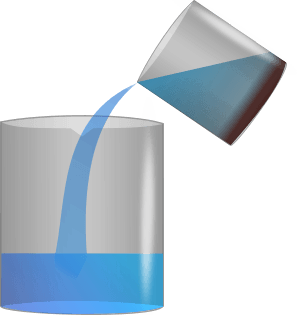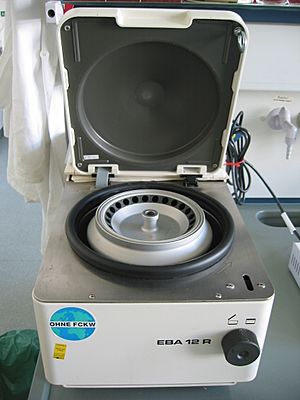Decantation facts for kids
Decantation is a simple way to separate mixtures. It's like pouring off the top part of a liquid, leaving the heavier stuff or another liquid behind. You can use it to separate two liquids that don't mix, like oil and water, or to separate a liquid from solid bits that have settled at the bottom. It's a common method used in labs and even in daily life!
Contents
How Decantation Works
Separating Liquids That Don't Mix
Decantation is great for separating liquids that don't mix together, also called immiscible liquids. These liquids usually have different densities. For example, if you mix oil and water, the oil will float on top because it's lighter (less dense) than water. You can then carefully pour the oil off the top, leaving the water behind.
It can be tricky to get a perfect separation this way. Sometimes, a little bit of the bottom liquid might pour out with the top one. For better separation, scientists often use a special tool called a separatory funnel. This funnel has a tap at the bottom, letting you drain the heavier liquid first.
Separating Solids from Liquids
Decantation is also used to separate solid particles from a liquid. This works because gravity pulls the solid pieces down, making them settle at the bottom of the container. Think of muddy water: the mud eventually sinks, leaving clearer water on top.
In a lab, you might put a test tube with a mixture at a 45-degree angle. This helps the solid bits settle faster.
Sometimes, waiting for solids to settle can take a long time. To speed things up, scientists use a machine called a centrifuge. A centrifuge spins the mixture very fast. This spinning force pushes the solid particles to the bottom of the container much quicker than gravity alone. The solids can even form a tight clump, called a pellet. Once the solids are packed at the bottom, it's much easier to pour the liquid away, leaving the solids behind.
There are also special machines called decanter centrifuges that can continuously separate solids from liquids.
Everyday Examples of Decantation
Decantation is used in many places, often without us even realizing it!
- Wine: When you see someone pouring red wine carefully from a bottle into another container, they are often decanting it. This helps separate the clear wine from tiny solid bits, like potassium bitartrate crystals, that can settle at the bottom of the bottle over time.
- Milk and Cream: Cream naturally rises to the top of milk because it's less dense. This allows the cream to be separated from the milk, which is important in making things like cheese.
- Muddy Water: If you have a glass of muddy water, you can let the mud settle to the bottom. Then, you can carefully pour off the clearer water from the top.
- Sugar Production: In factories that make sugar from sugar beets, decantation helps separate sugary liquids from solid crystals.
- Purifying Liquids: After using a substance called a desiccant to remove water from a liquid, the purified liquid can be decanted away from the desiccant.
- Making Vinegar: Decantation helps remove unwanted fats and other substances from the raw ingredients when making vinegar.
- Blood Separation: In hospitals, a centrifuge is used to separate plasma (the liquid part of blood) from blood cells. This is a type of decantation.
See also
 In Spanish: Decantación para niños
In Spanish: Decantación para niños





